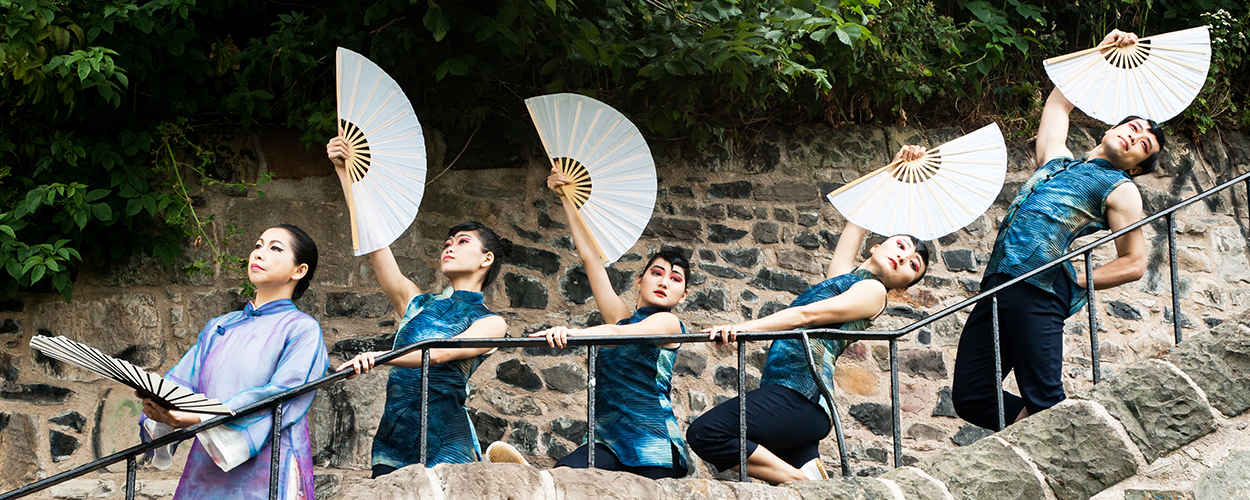This website uses cookies so that we can provide you with the best user experience possible. Cookie information is stored in your browser and performs functions such as recognising you when you return to our website and helping our team to understand which sections of the website you find most interesting and useful.
ED2016 Dance & Physical Theatre ED2016 Interviews ED2016 Week1 Edition
Hui-Chen Tan: The secret language of NuShu
By Chris Cooke | Published on Tuesday 9 August 2016

NuShu was a secret language used for centuries by the women of the Hunan province in China. Deprived a formal education, the women devised the language – and then handed it down from generation to generation – so that they could communicate with and support each other.
Intrigued by the story of NuShu, Taiwanese choreographer Tan Hui-Chen of the Water Reflection Dance Ensemble visited the region where the language originated to try and learn it for herself. From that experience she devised her show ‘NuShu’, which is being performed at Dance Base this Fringe. We spoke to her about this fascinating project.
CC: Tell us what NuShu was and why it existed.
HCT: NuShu is a secret language between women used in the Hunan province of China. It first came to wider attention in the 1980s, but to this day no one has been able to confirm just how long it has been in existence. It originally existed because women were not allowed to be formally educated but they wanted to be able to communicate with each other.
CC: This special language was almost lost. How much of it do we still know and understand today?
HCT: The women who used NuShu on a daily basis have all passed away, though there are still about ten or more descendents of NuShu speakers who make an extra effort to learn the language, even though nowadays, because they get to go to school, Mandarin is their main language. There are now also some classes in Hunan where you can learn NuShu, but I don’t think they are particularly well-attended
CC: Tell us about your visit to the region where NuShu originated.
HCT: I had only heard people talk about NuShu, but didn’t know much about the language itself. I was intrigued, so decided to investigate the possibility of going to Hunan to learn it. I wanted to create a dance work based on NuShu, because I fear it will soon disappear, and hope that my use of body language can help to record it for future generations. I felt that the only way to work out how to portray the language through dance was to live within the community it originated in for a month or so; to learn why the women didn’t get any traditional education and how they were nevertheless able to come up with this language; and to find out how the current generation of NuShu women want to pass on this tradition.
CC: What did you learn from your research into NuShu and the women who used it?
HCT: In ancient China, women were often subservient to men; for example, women bound their feet and wore three-inch golden lotus shoes because men enjoyed watching how they walked. But learning about the NuShu community, and how women created a language, and formed a really spiritual bond and support network through it, definitely changed my view on women being ‘soft’. And it made me think about my own memories, when I was young and living in countryside, and I now understand more about my mother’s stories and what she was going through.
CC: Tell us more about the show itself.
HCT: The show is a way for me to use dance to share the spiritual side of NuShu. The women in the community find happiness and comfort despite being in a helpless environment where women are viewed as nothing. The women who studied the language were under a lot of pressure, but they felt lucky to have NuShu to communicate with one another, and to have the mental support from others.
CC: Do you have any specific objectives with the piece?
HCT: My journey and exploration radically changed my view on women from this part of the world, because usually in Eastern culture we often think of women having to be obedient to men. So I would like the world to know about this group of strong and knowledgeable women who were enterprising enough to create a language all of their own.
CC: Tell us more about your company. Why did you set it up and what kind of work do you do?
HCT: I founded Water Reflection Dance Ensemble in 2001 with my husband Choon-Lin Lee, the company manager. I usually create work that is inspired by what I see and what interests me at any one time, though my ambition is to use the arts to connect and communicate different cultures, and especially women’s voices, from around the world.
CC: You performed at the Edinburgh Fringe before. What brings you back?
HCT: This is our first time being here for the whole Fringe, and we very much want to use this opportunity to let people know about our work as well as Taiwan’s many forms of artistic expression.
CC: You are performing at Dance Base this year – how did your alliance with the team there come about?
HCT: It’s so nice to perform in Dance Base and work with their excellent team. Artistic Director Morag Deyes saw our work and wanted very much to bring it here, and we could not refuse!
‘NuShu’ was performed at Dance Base at Edinburgh Festival 2016.
Photo by Kat Gollock






